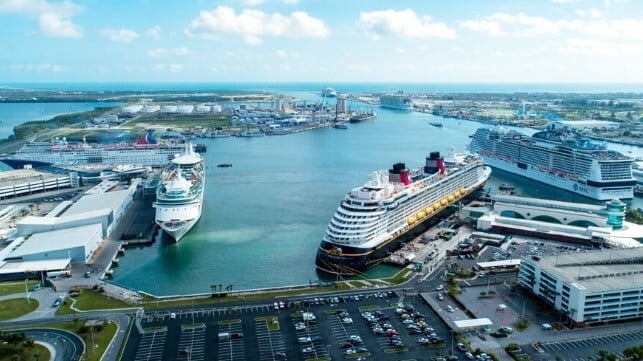Port Canaveral Tops Miami in Cruises as Florida Ports Rebound

Florida’s ports recovered in 2022 returning for the first time to pre-pandemic levels of activity. A new report from the Florida Ports Council highlights that last year cargo volumes exceeded 2019 levels after two down years, while the number of cruise passengers continues to grow but remains far behind its historic highs.
The state has a total of 16 commercial seaports which according to the nonprofit corporation that serves as the professional association for Florida’s public seaports collectively set a new record of 112.5 million tons of cargo. That represented a six percent increase over 2021 and just half a percent, or just under 600,000 tons, ahead of 2019.
Yet, while the cargo trade is surpassing previous levels, the cruise industry is still working to get back to its old volumes. While Florida remains the largest base for the global cruise industry, passenger volumes were still down more than 40 percent in 2022 versus 2019. The six Florida seaports that handle cruise passengers reported a total of 10.8 million passengers in 2022, more than 7.5 million passengers behind the 2019 peak.
One surprising change is that Port Canaveral handled the most number of passengers for the first time surpassing Port Miami which bills itself as the “cruise capital of the world.” The central Florida seaport, which is close to the theme park attractions in the Orlando area, handled 4.21 million passengers in 2022 compared to just over 4.0 million that passed through Miami. Port Everglades remains the third largest cruise port handling an additional 1.7 million passengers in 2022.
Among the factors that impacted the passenger business was the introduction of new large cruise ships and many travelers that preferred to stay closer to home especially avoiding international flights. Port Canaveral benefited from Carnival Cruise Line homeporting its largest cruise ship and the first LNG-fueled cruise ship in the U.S., the Mardi Gras (181,800 GT) at the port. Royal Caribbean International also has been operating the world’s largest cruise ship, Wonder of the Seas (235,500 GT) from the port. Port Canaveral highlights that it has 13 cruise ships homeporting this winter from five cruise lines, Carnival Cruise Line, Disney Cruise Line, MSC, Norwegian Cruise Line, and Royal Caribbean International.
"We’ve always aimed to be the best cruise port in the world, but what an achievement to now be known as the busiest,” said Capt. John Murray, CEO of Port Canaveral. “This historic milestone is testament to the efforts of our team and cruise partners to provide a best-in-class experience for all cruise guests sailing from Port Canaveral.”
The association credits the overall recovery to the resilience of the ports, the evolving mix of trade partners, and trade growth trade as Florida captures a larger share of international trade. Driving much of the growth is the increase in trade between Central and South America with the U.S. The U.S. Department of Commerce’s Bureau of Industry and Security reports that exports to Mexico were up by nearly a third between 2020 and 2021, while imports from Mexico grew just over 18 percent in 2021.
Port Tampa Bay leads in the state by cargo tonnage at 34.4 million tons in 2022 followed by Port Everglades at 27.3 million tons and Jaxport at 18.1 million tons. The volume at both Tampa Bay and Port Everglades is driven by liquid bulk.
Other than a slight decline in 2020, containerized cargo tonnage has been on a steady increase in Florida. Jaxport which has been investing in expanding its container handling capacity had the largest volume in Florida with over 1.3 million TEU last year but both Miami (1.197 million TEU) and Port Everglades (1.1 million TEU) also reported strong container traffic in 2022.
The Florida Ports Council projects that the growth trends will continue going forward highlighting that the nine ports that provided forecasts are all expecting tonnage and TEU growth over the next five years. They also highlight that it is anticipated that Florida’s cruise ports should reach 2019 passenger levels in 2023. Port Miami which set a record at over six million cruise passengers estimates it will see 8.4 million passengers by 2027, while Port Canaveral projects 6.4 million passengers in 2027, and Port Everglades expects the strongest percent growth nearing 5.2 million passengers in 2027.
Contributing to the overall growth are strong investments by the ports. Combined the five-year capital plans of the sixteen Florida seaports call for $3.97 billion in investments. The largest planned investments are for berth rehabilitation and repairs, site improvements, and cargo and cruise terminals. Michael Rubin, president and CEO of the Florida Ports Council says that Florida’s ports are taking a more aggressive approach to target maritime decision markers and to position the seaports as the gateway to the world.
